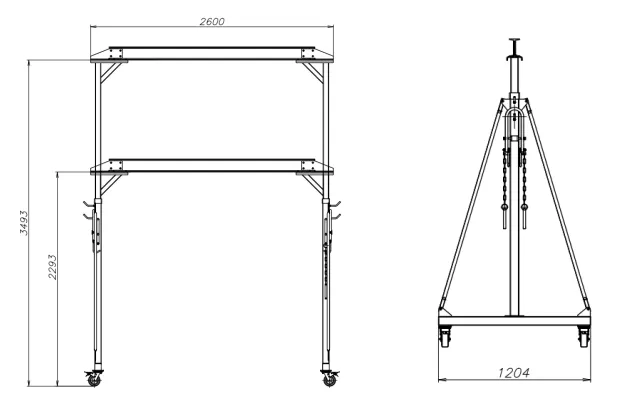3 Ton Overhead Crane Specifications and Applications for Efficient Material Handling Solutions
Understanding 3 Ton Overhead Cranes Features, Applications, and Benefits
Overhead cranes are essential equipment in various industries, facilitating the efficient movement of heavy materials. Among these, the 3-ton overhead crane stands out as a versatile solution well-suited for a range of applications. Whether in manufacturing plants, warehouses, or construction sites, understanding the features, applications, and benefits of a 3-ton overhead crane is crucial for optimizing operational efficiency.
Features of a 3 Ton Overhead Crane
A 3-ton overhead crane typically consists of several key components that work together to lift and transport heavy loads. The primary parts include the bridge, runway, hoist, and trolley.
1. Bridge The bridge is the main support structure that spans the width of the work area. It allows the hoist to travel from one end to the other, enabling the movement of loads across significant distances.
2. Runway The runway consists of rails that the bridge travels on. Proper installation of the runway is essential for the seamless operation of the crane. It must be adequately aligned to support the crane’s movements safely and effectively.
3. Hoist The hoist is the heart of the overhead crane. It is responsible for lifting and lowering the loads. In a 3-ton crane, the hoist is designed to handle loads up to 3 tons, ensuring that it can manage various materials commonly used in industrial applications.
4. Trolley The trolley carries the hoist along the bridge. It allows for lateral movement, enhancing the crane’s versatility. The combination of trolley movement and hoist capability enables precise positioning of loads.
5. Control System Modern 3-ton overhead cranes feature advanced control systems that provide operators with the ability to manage lifting operations safely and efficiently. These systems may be operated via remote control, enhancing safety by allowing operators to maintain a safe distance from potential hazards.
Applications of a 3 Ton Overhead Crane
The versatility of a 3-ton overhead crane makes it suitable for various applications across different industries
1. Manufacturing In manufacturing facilities, these cranes are commonly used for moving heavy machinery, raw materials, and finished products. They streamline workflow and reduce the risk of workplace injuries associated with manual lifting.
3 ton overhead crane

2. Warehousing Warehousing operations benefit from overhead cranes as they provide a safe and efficient method to stack and retrieve heavy items. The 3-ton capacity allows for the handling of a wide range of goods, from pallets of materials to large components.
3. Construction In construction, a 3-ton overhead crane can be indispensable for lifting steel beams, concrete blocks, and other heavy materials. They facilitate fast and safe construction processes, helping to maintain project timelines.
4. Shipping and Logistics Overhead cranes are also used in shipping yards and logistics centers to load and unload cargo containers. Their ability to lift heavy loads with precision promotes efficiency in shipping operations.
Benefits of Using a 3 Ton Overhead Crane
Implementing a 3-ton overhead crane within an operation yields numerous advantages
1. Increased Efficiency Overhead cranes significantly enhance productivity by allowing for quick and efficient movement of heavy loads, minimizing downtime.
2. Safety These cranes reduce the risk of injuries associated with manual lifting and provide operators with a safe means to engage with heavy materials.
3. Space Optimization Overhead cranes operate above ground level, freeing up floor space for other activities, which is particularly valuable in crowded industrial environments.
4. Cost-Effectiveness With the ability to handle various lifting tasks, businesses can rely on a single piece of equipment to meet diverse needs, offering long-term cost savings.
Conclusion
A 3-ton overhead crane serves as a pivotal piece of equipment in many industries, providing powerful lifting solutions that enhance efficiency, safety, and productivity. By understanding its features, applications, and benefits, businesses can make informed decisions regarding the integration of overhead cranes into their operations, ultimately leading to improved performance and operational success. As technology evolves, these cranes continue to adapt, ensuring they meet the dynamic needs of modern industry.
-
Unlock Seamless Relocation with Our Heavy Equipment Moving ExpertiseNewsJun.06,2025
-
Unleash Unrivaled Flexibility with Our Adjustable Gantry CraneNewsJun.06,2025
-
Unleash Heavy-Duty Efficiency with Our Industrial Gantry Crane SolutionsNewsJun.06,2025
-
Revolutionize Steel Handling with Our Magnetic Lifter RangeNewsJun.06,2025
-
Master Equipment Mobility with Premium Machinery Mover SolutionsNewsJun.06,2025
-
Elevate Your Material Handling with Magnetic Lifter TechnologyNewsJun.06,2025
-
YS Permanent Lifting Magnets: The Smarter Way to Handle SteelNewsMay.22,2025
